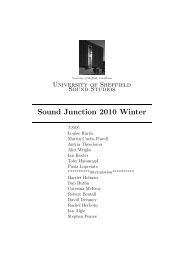Compositional Methods in Electroacoustic Music - Adrian Moore ...
Compositional Methods in Electroacoustic Music - Adrian Moore ...
Compositional Methods in Electroacoustic Music - Adrian Moore ...
You also want an ePaper? Increase the reach of your titles
YUMPU automatically turns print PDFs into web optimized ePapers that Google loves.
diagnostic, enquir<strong>in</strong>g and creative about the sonic artefacts that many digital audio process<strong>in</strong>g rout<strong>in</strong>es create,<br />
especially when these process<strong>in</strong>g rout<strong>in</strong>es are deliberately abused. Sounds generated, and the techniques<br />
explored, lend themselves to compositional works that comb<strong>in</strong>e abstract sonic gestures, experimental soundscapes,<br />
and/or rhythmic ‘electronica’ for the more ‘timid’ students. The techniques learnt can be <strong>in</strong>tegrated<br />
back <strong>in</strong>to a wide variety of more sophisticated process<strong>in</strong>g rout<strong>in</strong>es, as well as hav<strong>in</strong>g currency <strong>in</strong> a broader<br />
range of contemporary music productions. Assignment submission is <strong>in</strong> the form of the Pro Tools session itself,<br />
which must be able to play the result<strong>in</strong>g composition upon open<strong>in</strong>g <strong>in</strong> its native state. As an additional<br />
challenge, through a creative use of signal generators, volume and delay automation and automated <strong>in</strong>ternal<br />
feedback rout<strong>in</strong>gs some students can achieve sections or even whole compositions that have absolutely no audio<br />
regions at all.<br />
Paper 17 - Composition teach<strong>in</strong>g and employability skills.<br />
10:30<br />
Otondo, Felipe<br />
Lancaster Institute for the Contemporary Arts, Lancaster University.<br />
The presentation will discuss various aspects of a research project funded by the Higher Education Academy<br />
currently tak<strong>in</strong>g place at Lancaster University. The project aims to explore the relationship between specific<br />
composition skills taught at music technology BA courses <strong>in</strong> the UK and skills valued by employers with<strong>in</strong><br />
the creative <strong>in</strong>dustries. The first part of the presentation will discuss ways of enhanc<strong>in</strong>g specific and generic<br />
employability skills embedded <strong>in</strong> composition teach<strong>in</strong>g us<strong>in</strong>g as examples some of the <strong>in</strong>itial f<strong>in</strong>d<strong>in</strong>gs of the<br />
project. The second part of the presentation will be an open discussion with members of the audience where<br />
participants will contribute with their own views on the topic of composition teach<strong>in</strong>g and employability.<br />
Paper 18 - Display<strong>in</strong>g the Beauty: the Beachcomber-Bowerbird approach to composition.<br />
11:00<br />
Whistlecroft, Lisa<br />
The call for papers for From Tape to Typedef describes a number of possible compositional methods, but<br />
starts with this one: ‘In some cases, composers rely upon serendipity, - sounds are ‘found’, process<strong>in</strong>g is <strong>in</strong>herently<br />
experimental, and the electroacoustic work emerges gradually, without predeterm<strong>in</strong>ation or plann<strong>in</strong>g.’<br />
This paper proposes a name for this method, draw<strong>in</strong>g parallels between the author’s methods <strong>in</strong> musical composition<br />
and <strong>in</strong> her ’w<strong>in</strong>dow ledge’ practice.<br />
Questions raised <strong>in</strong>clude: Is ‘search<strong>in</strong>g’ a necessary pre-requisite for ‘f<strong>in</strong>d<strong>in</strong>g’? If sound process<strong>in</strong>g is used less<br />
as a ’compositional process’ and more as a realm <strong>in</strong> which the same ‘f<strong>in</strong>d<strong>in</strong>g’ process takes place, how does<br />
this change the composer’s approach to tools? Are the aesthetic decisions <strong>in</strong>volved <strong>in</strong> selection (i.e. <strong>in</strong> effective<br />
rejection) similar to those assumed to act <strong>in</strong> ‘creation’?<br />
An ‘<strong>in</strong>tuitive’, unformalised, non-methods-based practice may be artistically valid but is it academically valid?<br />
How can knowledge and skills be developed? Can it be taught - or only mentored?<br />
Caveats: Answers to these questions may not be offered.<br />
The author does not wish to imply by her proposal that composition is (just) part of a mat<strong>in</strong>g ritual!<br />
Rationale (with acknowledgment to Wikipedia):<br />
Beachcomber: In modern usage ‘beachcomb<strong>in</strong>g’ usually describes the recreational activity of look<strong>in</strong>g for (and<br />
tak<strong>in</strong>g away) th<strong>in</strong>gs that have been deposited by the tide. These may be natural or man-made, but are claimed<br />
because they are either decorative or useful <strong>in</strong> some way to the collector.<br />
But how is ‘decorative or useful’ def<strong>in</strong>ed, for any particular beachcomber at any particular time? What is it<br />
that attracts <strong>in</strong> this object that is lack<strong>in</strong>g <strong>in</strong> that? Where/when/how <strong>in</strong> the collector’s conscious or unconscious<br />
m<strong>in</strong>d is a selection made, and on what criteria? And does the f<strong>in</strong>d<strong>in</strong>g or the choice of one object <strong>in</strong>fluence<br />
the subsequent selection of others?<br />
And what does the collector do, later, with the day’s hoard?<br />
19



